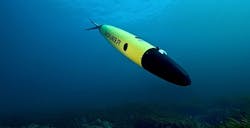DARPA Blue Wolf program seeks revolutionary breakthroughs in undersea vehicle speed and efficiency
ARLINGTON, Va., 11 July 2014. U.S. military researchers are trying to develop revolutionary propulsion and drag-reduction technologies to enable manned and unmanned undersea vehicles to move through the water faster and more energy-efficiently than ever before.
Officials of the U.S. Defense Advanced Research Projects Agency (DARPA) in Arlington, Va., are working toward at-sea testing of undersea energy, hydrodynamic lift, and drag-reduction technologies as part of the Blue Wolf program.
DARPA outlined the program and its unclassified goals in an industry solicitation (DARPA-BAA-14-28) released Wednesday. The program seeks to modify existing hardware and systems to establish the vehicle baseline, and will seek technical solutions from industry to achieve the program goals that are outlined in classified documents available to companies with appropriate security clearances.
The Blue Wolf program will develop and demonstrate integrated underwater vehicle prototypes able to operate at speed and range combinations previously unachievable in fixed-size platforms, while retaining traditional volume and weight fractions for payloads and electronics, DARPA officials say.
Related: DARPA considers unmanned submersible mothership designed to deploy UAVs and UUVs
From industry, DARPA is seeking proposals for novel concept designs, dynamic lift and drag reduction systems, and innovative hybrid energy systems.
Concept designs refers to innovative proposals for alternative point designs for a fast, low-drag, and energy-efficient undersea vehicle that will provide not only insights into the strengths, weaknesses, and risks in the prototype vehicle, but also provide alternative design strategies and concepts of operations.
Dynamic lift and drag reduction refers to revolutionary technologies for significant drag reduction, such as dynamic lift from winglets, body shaping, coatings, and novel drag reduction technologies applicable over various range and speed combinations to improve system energy efficiency.
Hybrid energy systems refers to approaches such as thermal, electrochemical, or energy-harvesting with two or more energy sources to improve energy efficiency measured in Watt hours per mile. DARPA researchers say they plan to explore thermal and electric sources like fuel cells and batteries that can fit within an undersea vehicle system module.
Related: DARPA to keep military communications open with floating optical fiber and networking buoys
Undersea vehicle size, weight, and volume, traditionally are limited by handling, launch and recovery systems, DARPA officials explain. Mission performance typically sets the range, endurance, speed, and depth requirements, and the range of underwater vehicles is limited by the amount of energy available for propulsion and the power required for a given underwater speed.
This means that for a given speed, range, and volume necessary for payloads and electronics, vehicle size is proportional to energy needed for the mission envelope.
While designers can modify this envelope by reducing hydrodynamic drag, improving lift-to-drag performance, or by improving the volumetric energy density of energy sources, the volume and weight needed for systems to reduce drag or improve lift-to-drag in a fixed-size vehicle also reduces the volume and weight available for energy.
The Blue Wolf program seeks to break free of these limitations by focusing on rapid testing and maturation of novel energy, hydrodynamic lift, and drag-reduction technologies.
Testing will be on existing undersea vehicles at the U.S. Naval Undersea Warfare Center (NUWC) in Newport, R.I., and at the Penn State Applied Research Laboratory in Reston, Va. NUWC will manage safety, certification, and vehicle development, while Penn State will provide technical expertise.
The initial reference architecture consists of a 21-inch-diameter vehicle with volume and weight reserved for baseline guidance, control, electronic systems, and payload section. The vehicle will use a baseline electric drive and conventional fin control.
The first phase of the Blue Wolf program will be a 12-month effort to design component and subsystem technologies for dynamic lift, drag reduction, and energy systems. An optional second phase will develop modules, and demonstrate safety, performance, and readiness for integration.
Related: DARPA chooses Sparton to help develop hidden weapons and sensors that pop up from the ocean
The total amount that DARPA has for the initial phase of the Blue Wolf program is about $17 million, and several contractors will be involved in the program's early phases.
Companies interested should submit abstracts no later than 1 Aug. 2014, and full proposals no later than 4 Sept. 2014. Email questions or concerns to DARPA at DARPA-BAA- [email protected].
More information is online at https://www.fbo.gov/spg/ODA/DARPA/CMO/DARPA-BAA-14-28/listing.html.

